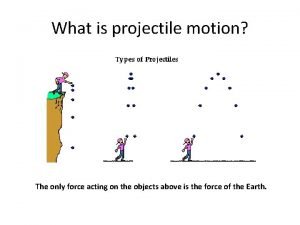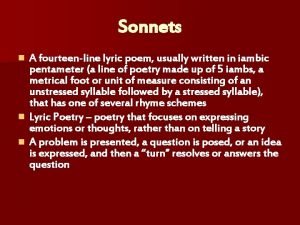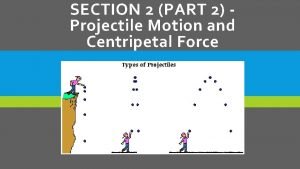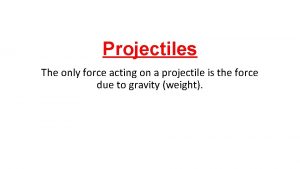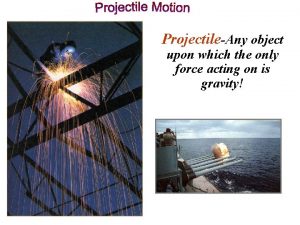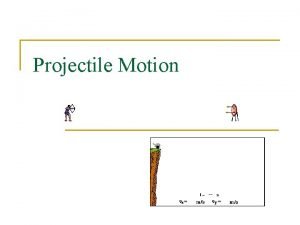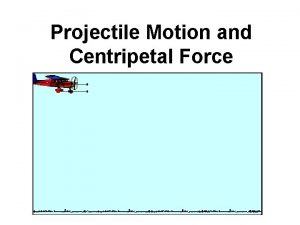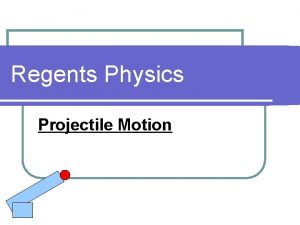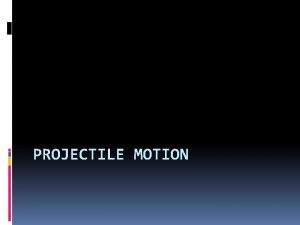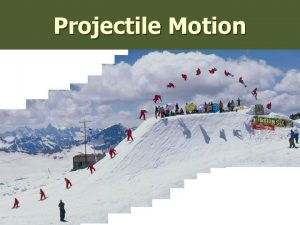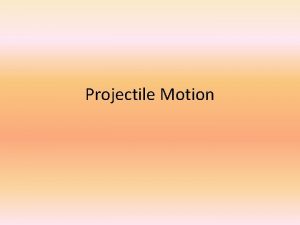Section 3 7 Projectile Motion A projectile is












- Slides: 12

Section 3 -7: Projectile Motion

A projectile is an object moving in two dimensions under the influence of Earth's gravity; its path is a parabola.

Projectile Motion • Projectile Motion of an object that is projected into the air at an angle. • Near the Earth’s surface, the acceleration a on the projectile is downward and equal to a = g = 9. 8 m/s 2 – Goal: Describe motion after it starts. • Galileo: Analyzed horizontal & vertical components of motion separately. • Today: Displacement D & velocity v are vectors Components of motion can be treated separately

Projectile Motion • Simplest example: Ball rolls across table, to the edge & falls off edge to floor. Leaves table at time t = 0. Analyze y part of motion & x part of motion separately. • y part of motion: Down is positive & origin is at table top: y 0 = 0. Initially, no y component of velocity: vy 0 = 0 vy = gt, y = (½)g t 2 • x part of motion: Origin is at table top: xf = 0. No x component of acceleration(!): ax = 0. Initially x component of velocity is: vx vx = vx 0 , x = v 0 t

Ball Rolls Across Table & Falls Off t = 0 here Can be understood by analyzing horizontal vertical motions separately. Take down as positive. Initial velocity has an x component ONLY! That is vy 0 = 0. At any point, v has both x & y components. Kinematic equations tell us that, at time t, vx = vx 0, vy = gt x = vx 0 t y = (½)gt 2

• Summary: Ball rolling across table & falling. • Vector velocity v has 2 components: vx = vx 0 , vy = gt • Vector displacement D has 2 components: x = vx 0 t , y = (½)g t 2

The speed in the x-direction is constant; in the y-direction the object moves with constant acceleration g. Photo shows two balls that start to fall at the same time. The on the right has an initial speed in the x-direction. It can be seen that vertical positions of the two balls are identical at identical times, while the horizontal position of the yellow ball increases linearly.

• PHYSICS: y part of motion: vy = gt , y = (½)g t 2 SAME as free fall motion!! An object projected horizontally will reach the ground at the same time as an object dropped vertically from the same point! (x & y motions are independent)

General Case: Object is launched at initial angle θ 0 with the horizontal. Analysis is similar to before, except the initial velocity has a vertical component vy 0 0. Let up be positive now! vx 0 = v 0 cosθ 0 vy 0 = v 0 sinθ 0 but, acceleration = g downward for the entire motion! Parabolic shape of path is real (neglecting air resistance!)

• General Case: Take y positive upward & origin at the point where it is shot: x 0 = y 0= 0 vx = v 0 cosθ 0, vy = v 0 sinθ 0 • Horizontal motion: NO ACCELERATION IN THE x DIRECTION! vx = vx 0 , x = vx 0 t • Vertical motion: vy = vy 0 - gt , y = vy 0 t - (½)g t 2 (vy) 2 = (vy 0)2 - 2 gy – If y is positive downward, the - signs become + signs. ax = 0, ay = -g = -9. 8 m/s 2

Summary: Projectile Motion Projectile motion is motion with constant acceleration in two dimensions, where the acceleration is g and is down.

Solving Problems Involving Projectile Motion 1. Read the problem carefully, &choose the object(s) you are going to analyze. 2. Sketch a diagram. 3. Choose an origin & a coordinate system. 4. Decide on the time interval; this is the same in both directions, & includes only the time the object is moving with constant acceleration g. 5. Solve for the x and y motions separately. 6. List known & unknown quantities. Remember that vx never changes, & that vy = 0 at the highest point. 7. Plan how you will proceed. Use the appropriate equations; you may have to combine some of them.
 Chapter 2 motion section 1 describing motion answer key
Chapter 2 motion section 1 describing motion answer key Measuring motion
Measuring motion Chapter 2 section 1 describing motion answer key
Chapter 2 section 1 describing motion answer key Section 1 describing motion worksheet answer key
Section 1 describing motion worksheet answer key Section 1 describing motion
Section 1 describing motion You accidentally throw your car keys horizontally
You accidentally throw your car keys horizontally Symmetrical projectile motion
Symmetrical projectile motion Translational motion diagram
Translational motion diagram Fourteen line lyric poem
Fourteen line lyric poem An object in projectile motion will follow which path?
An object in projectile motion will follow which path? What is the only force acting on the projectile
What is the only force acting on the projectile Forces acting on a projectile
Forces acting on a projectile Table 2.1.3 horizontal motion description
Table 2.1.3 horizontal motion description





